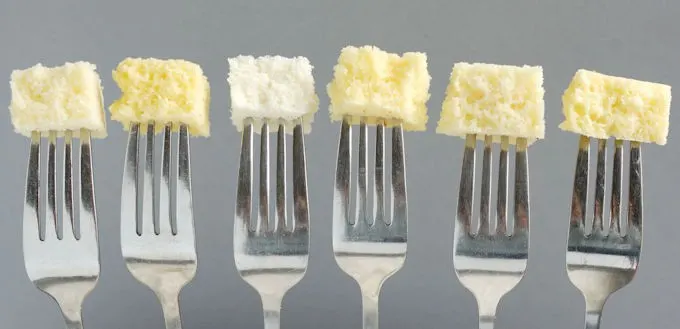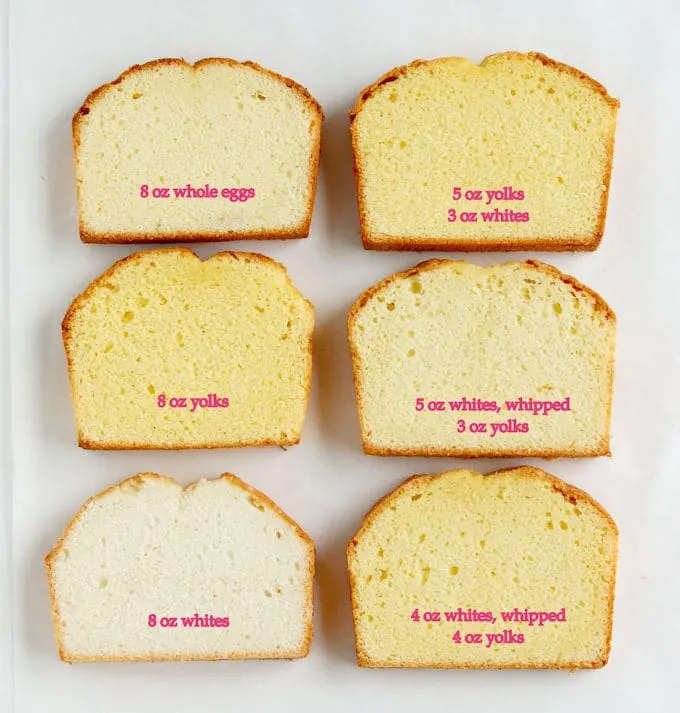🥚 The Role of Eggs in Cake Structure
How whole eggs, yolks, and whites each shape a cake’s texture and rise.
Eggs are the unsung multitaskers of cake batter. They add structure, richness, color, and even lift.
The proteins in both the yolk and the white coagulate as the cake bakes, setting the crumb along with the starch in the flour.
By adjusting the number of yolks and whites, you can dramatically change how a cake behaves, from dense and rich to light and airy.

⚖️ How Eggs Build Structure
In a balanced cake recipe, flour and eggs create the framework while sugar and fat tenderize it.
When heated, egg proteins unfold and then bond, creating a stable network that traps air and moisture.
This network, combined with the starch gel from flour, forms the cake crumb, the delicate, spongy structure we see when we cut into a well-baked cake.
🍳 What Egg Yolks Do
Egg yolks contribute:
- Protein – for structure
- Fat and flavor – for richness
- Emulsifiers (lecithin) – to help water and fat blend smoothly
Because emulsifiers allow the batter to hold extra liquid and sugar, adding more yolks makes a cake moister and sweeter without compromising structure. Extra yolks are especially useful in high-ratio cakes, where sugar and liquid exceed the flour weight.
☁️ What Egg Whites Do
Egg whites are nearly pure protein and water. When whipped, they trap air bubbles and partially coagulate, creating a foam that can be folded into batter for natural leavening.
Whipped whites add lightness but slightly reduce structure since those partially set proteins can’t bond as tightly once baked.
In testing, cakes made with whipped whites had a softer crumb and more open texture compared to those using whole eggs alone.
If you’d like to dive deeper into how eggs function in baking beyond cakes—adding structure, color, and emulsification—see my guide on Eggs in Baking.
🧪 Testing Egg Ratios in Pound Cake
To see how yolks and whites affect structure, I baked six versions of my classic quatre quarts pound cake, keeping butter, sugar, and flour constant at 8 oz each but varying the egg composition.
- Some batters used whole eggs.
- Some had extra yolks (for richness).
- Some had extra whites (for structure).
- In two versions, I whipped the whites with sugar and folded them into the batter.
The differences were striking:
- Extra yolks produced a moist, velvety crumb and deeper flavor.
- Extra whites made the cake firmer and lighter in color.
- The versions with whipped whites rose higher and felt lighter on the palate.
There’s no single “best” combination, it depends on what you want your cake to be. Understanding how to tweak the yolk-to-white ratio gives you precise control over texture and sweetness.

Baking Sense Tip
For a moister, richer cake, replace some whites with extra yolks.
For more lift and lighter texture, separate and whip the whites before folding them in.
🧩 Takeaway
Eggs are the structural backbone and the balancing agent of cake. They set the crumb, carry flavor, and bind fat and liquid into a cohesive batter.
Once you understand how yolks and whites behave independently, you can adjust any cake recipe to be lighter, firmer, or moister, exactly how you like it.
📚 Continue Learning
This lesson is part of my Cake Recipe Science series, where I explain how each ingredient and mixing method shapes a cake’s structure, texture, and flavor. Explore the full series to learn how flour, sugar, eggs, fats, and leavening work together to create the perfect cake crumb.
← Previous: Fats in Cake Recipes | Next: Sugar in Cake Recipes →
